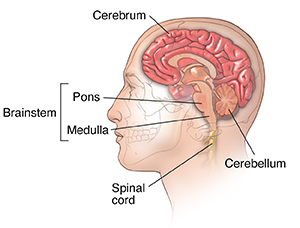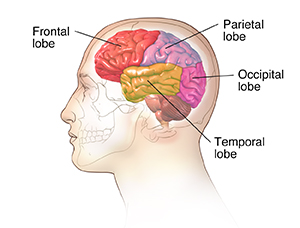Anatomy of the Brain
What is the central nervous system (CNS)?
The CNS consists of the brain and spinal cord. The brain is an important organ that
controls thought, memory, emotion, touch, motor skills, vision, breathing, temperature,
hunger, and every process that regulates our body. The brain determines your personality
and how you interact with the environment, including other people. This defines who
you are.
What are the different parts of the brain?


The brain can be divided into the cerebrum, brainstem, and cerebellum:
-
Cerebrum. This is the front of the brain. It is made up of the right and left hemispheres,
which are joined by the corpus callosum. The cerebrum controls: initiation of movement,
coordination of movement, temperature, touch, vision, hearing, judgment, reasoning,
problem solving, emotions, and learning. The cerebrum is responsible for communication
(speaking and writing), memory, abstract thought, and appreciation for music and art.
-
Brainstem. This is the middle of the brain. It includes the midbrain, the pons, and the medulla.
The brainstem controls movement of the eyes, face, and mouth. It also relays sensory
messages (such as hot, pain, and loud) and controls respirations, consciousness, cardiac
function, involuntary muscle movements, sneezing, coughing, vomiting, and swallowing.
-
Cerebellum. This is the back of the brain. It coordinates voluntary muscle movements and helps
to maintain posture, balance, and equilibrium.
More specifically, other parts of the brain include the following:
-
Pons. A deep part of the brain, located in the brainstem, the pons contains many of the
control areas for eye and face movements.
-
Medulla. The lowest part of the brainstem, the medulla is the most vital part of the entire
brain and contains important control centers for the heart and lungs.
-
Spinal cord. A large bundle of nerve fibers located in the back that extends from the base of the
brain to the lower back, the spinal cord carries messages to and from the brain and
the rest of the body.
-
Frontal lobe. The largest section of the brain located in the front of the head, the frontal lobe
is involved in personality characteristics and movement. Recognition of smell often
involves parts of the frontal lobe.
-
Parietal lobe. The middle part of the brain, the parietal lobe helps a person to identify objects
and understand spatial relationships (where one's body is compared to objects around
the person). The parietal lobe is also involved in interpreting pain and touch in
the body.
-
Occipital lobe. This is the back part of the brain that is involved with vision.
-
Temporal lobe. The sides of the brain, these temporal lobes are involved in short-term memory, speech,
musical rhythm, and some degree of smell recognition. The temporal lobes are also
important in understanding sound and voice.